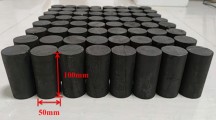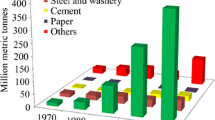Abstract
For further understanding the coal spontaneous combustion in goaf, the dynamic evolution of the oxygen concentration field influenced by the condition of negative pressure of cross-cut were analyzed. Based on the on-site testing results, the range of the oxidation zone on the headentry and tailentry side is determined as 30 ~ 75 m and 15 ~ 65 m respectively. This paper adopts a new method called “fixed grid, dynamic attribute” to dynamically describe the spatial change of goaf caused by working face advancing. The validated model which developed by field measured data is used to study the dynamic evolution of negative pressure impact of cross-cut on oxygen concentration field in goaf. The results demonstrate that when the cross-cut is located at different positions of three zones of coal spontaneous combustion, the negative pressure of the cross-cut has different impact rules on the distribution of oxygen concentration field. The results are hopeful for providing effective guidance for coal mine fire prevention in goaf.












Similar content being viewed by others
References
Yuan J (2018) The future of coal in China. Resour Conserv Recy 129:290–292
Wang D (2018) Thermodynamic disaster in coal mine and its characteristics. J China Coal Soc 43:137–142
Tang Y, Wang H (2019) Experimental investigation on microstructure evolution and spontaneous combustion properties of secondary oxidation of lignite. Process Saf Environ 124:143–150
Ning W, Wen Z, Tao Z (2015) An estimation of regional emission intensity of coal mine methane based on coefficient-intensity factor methodology using China as a case study. Greenh Gases 5:437–448
Lee J, Wang Y (1984) Effects of stopping leakage on coal mine ventilation systems. Geotech Geol Eng 2:253–259
Yuan L (2009) Theory of pressure-relieved gas extraction and technique system of integrated coal production and gas extraction. J China Coal Soc 34:1–8
Ren T, Balusu R (2005) CFD Modelling of Goaf gas migration to improve the control of spontaneous combustion in Longwalls. 6th Australasian coal operators conference Brisbane Australia
Li Z, Wu Q, Xiao Y (2008) Numerical simulation of coupling mechanism of coal spontaneous combustion and gas effusion in goaf. J China U Min Technol 37:38–42
Yu M, Zhao ZH, Chu T et al (2011) The influence of gas drainage on goaf spontaneous combustion and its prevention measures. Journal of Henan Polytechnic University (Natural Science) 5:505–509
Yang S, Chen T, Chen Q et al (2011) Theoretical analysis and numerical simulation of influence of the change of negative pressure and air volume of inner interlocked tail road on coal spontaneous combustion. J China Coal Soc 36:308–312
Chu T, Yu M, Yang S et al (2010) Coupling between gas drainage and spontaneous combustion about close distance coal seams in U+II type workface. J China Coal Soc 35:2082–2087
Chu T, Liu C, Yu M et al (2010) Influential effect on spontaneous combustion of float coal induced by gas extraction in upper roadway. J Min Saf Eng 29:421–428
Zhang M, Yang S, Cheng J (2013) Spontaneous heating and gas drainage on a coal face with "four-gateroad" and overlying drainage tunnel. J China U Min Technol 42:513–518
Zhu H, Liu X (2012) Theoretical investigation on the relationship between tail roadway methane drainage and distribution of easily spontaneous combustible region in gob. Safety Sci 50:618–623
Xia T, Zhou F, Wang X (2017) Safety evaluation of combustion-prone longwall mining gobs induced by gas extraction: a simulation study. Process Saf Environ 109:677–687
Deng Q, Liu X (2012) Lu C (2013) numerical simulation of spontaneous oxidation zone distribution in Goaf under gas stereo drainage. International conference on performance-based fire and fire protection engineering 52:72–78
Qin Z, Yuan L, Guo H (2015) Investigation of longwall goaf gas flows and borehole drainage performance by CFD simulation. Int J Coal Geol 150:51–63
Yuan L, Smith A (2008) Numerical study on effects of coal properties on spontaneous heating in longwall gob areas. Fuel 87:3409–3419
Taraba B, Michalec Z (2011) Effect of longwall face advance rate on spontaneous heating process in the gob area CFD modelling. Fuel 90:2790–2797
Shi G, Liu M, Wang Y et al (2015) Computational fluid dynamics simulation of oxygen seepage in coal mine goaf with gas drainage. Math Probl Eng 2015:1–9
Shi G, Ding P, Guo Z et al (2019) Modeling temperature distributions upon liquid-nitrogen injection into a selfheating coal mine goaf. Process Saf Environ 126:278–286
Liu M, Shi G, Guo Z et al (2016) 3-D simulation of gases transport under condition of inert gas injection into goaf. Heat Mass Transf 12:2723–2734
Yuan L, Smith A (2009) CFD modeling of spontaneous heating in a large-scale coal chamber. J Loss Prevent Proc 22:426–433
Chien M (1981) A study of the behaviour of overlying strata in Longwall mining and its application to strata control. Dev Geotech Eng 32:13–17
Shi G, Hu F, Wang D et al (2014) Unsteady simulation on distribution of three zones for spontaneous combustion in goaf areas. J China U Min Technol 2:189–194
Shi G, Wang D, Zhong X et al (2010) CFD simulation of oxidation zones distribution in goal of fully-caving mechanized caving face. J Min Saf Eng 27:568–571
Li Z, Gu R, Zhang X et al (2014) Simulation of gas migration in 3D goaf based on RNG k-ε turbulence model. J China Coal Soc 39:880–885
Acknowledgements
The authors deeply appreciate the financial supports provided by the National Key Research and Development Program of China (No. 2016YFC0802900).
Author information
Authors and Affiliations
Corresponding author
Ethics declarations
Conflict of interest
The authors declared that we have no conflicts of interest to this work.
Additional information
Publisher’s note
Springer Nature remains neutral with regard to jurisdictional claims in published maps and institutional affiliations.
Rights and permissions
About this article
Cite this article
Chen, L., Yang, J. & Ding, P. Dynamic evolution of negative pressure impact of cross-cut on oxygen concentration field in coal mine Goaf. Heat Mass Transfer 57, 737–749 (2021). https://doi.org/10.1007/s00231-020-02981-z
Received:
Accepted:
Published:
Issue Date:
DOI: https://doi.org/10.1007/s00231-020-02981-z




